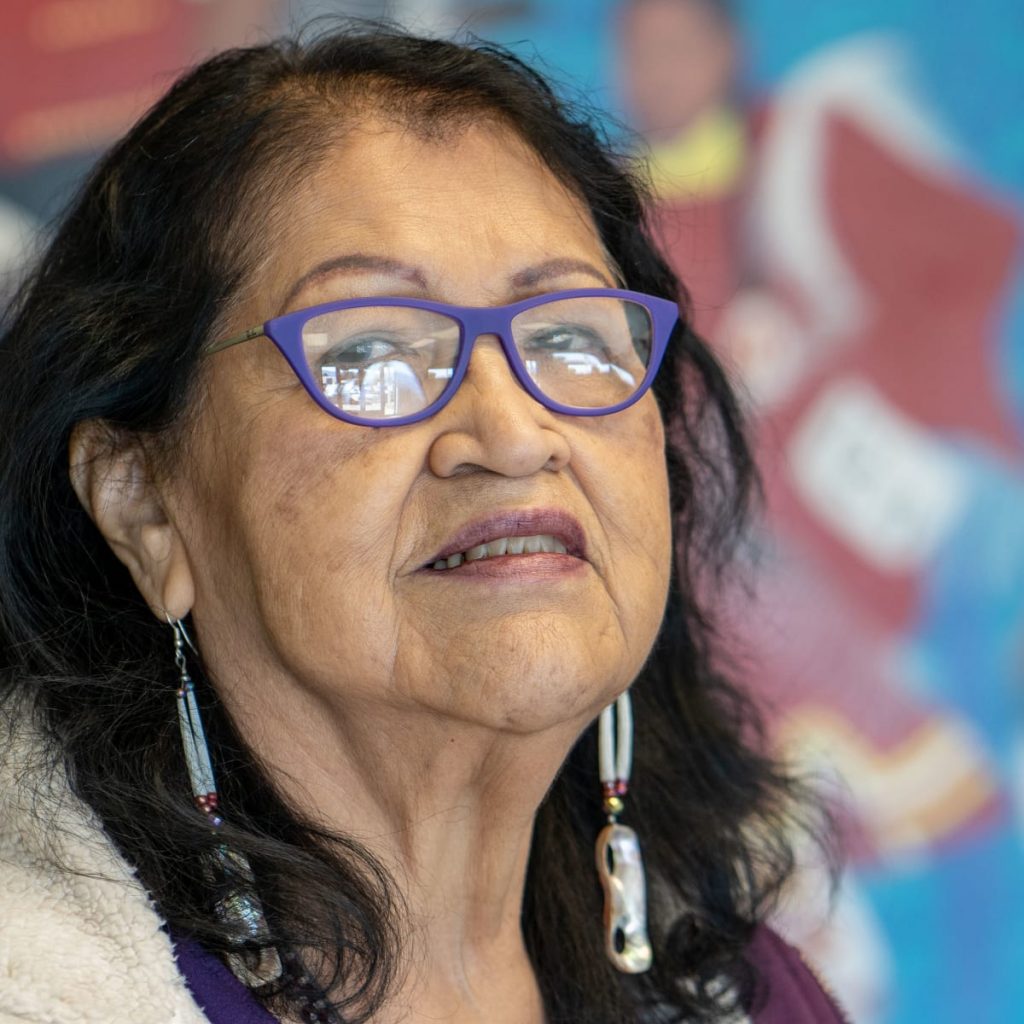
Untitled (Covergirl)
Jean LaMarr
- 1989
- Offset Lithograph
- Image/sheet: 21.5 x 30"
- 96 prints in this edition
About the Print
From the Artist
My work focuses on pride in our heritage because the town I grew up in is very racist. I was proud of being Indian, but nothing was supportive of this. There was very little community activity, very little ceremony, very little traditional activity. But I knew something important was there and felt that something had to be done.
I was always an artist in school; they were always having me do the classroom art. They had me paint a mural of Sir Francis Drake christening the Indians, the Indians bowing down to him. Well, this was the beginning of some of the mural work that I did.
Mural work is so important to me. I like to do large paintings, but I didn’t like the European mentality of having one painting for one patron or just one person. I like the community-art aspect. I was affected by the Chicano art movement. They did murals around town for the community. Also, I began in printmaking. I just loved to print because it was multiples—many prints for many people. I liked what Jules Heller had to say about the print medium: it is for so many thousands of people, while one painting is for one person for many thousands of dollars.
—Excerpted from https://www.culturalsurvival.org/publications/cultural-survival-quarterly/interview-jean-la
Brandywine artist prints celebrate cultural diversity and allow the viewer to experience the richness of the human condition firsthand. Jean LaMarr’s representational work validates gender and cultural identity and manifests a positive self for those who remain invisible. LaMarr’s paintings illustrate and dramatize the cultural divide that exists between Native Americans and non-Native Americans. Untitled (Covergirl) depicts a Native American woman wearing a traditional rawhide skirt and leggings as well as a non-traditional lace bodice. LaMarr’s goal, she says, is to create a visual experience that allows viewers to interact with both Indian and non-Indian cultures. She used printmaking as a tool for political art after being inspired by the Chicano mural and printmaking movement in California. In her 1989 Cover Girl Series, LaMarr silkscreened exploitative nineteenth-century photographs of half-dressed native women with clothing, jewelry, and basketry to reclaim the women’s dignity and respect.
—Adapted from Brandywine Workshop and Archives records and “Fresh, Human and Personal: Signature of Brandywine Workshop,” Three Decades of American Printmaking: The Brandywine Workshop Collection (Manchester, VT: Hudson Hills Press, 2004)
About the Artist
Native American artist and activist Jean LaMarr was born in Susanville, CA, and is a member of the Paiute and Pit River tribes. She studied at San Jose City College, CA; University of California, Berkeley; and Kala Art Institute, Berkeley.
Inspired by California’s Chicano mural and printmaking movement, LaMarr embraced printmaking as a vehicle for political art. In 1986, she founded the Native American Graphic Workshop in Susanville. LaMarr’s art addresses issues such as cultural stereotypes, representations of women and Native Americans—her 1989 Cover Girl series utilized printmaking to reclaim images of American Indian women—and the traditions of her ancestors. While she has worked primarily in printmaking, she is also known for her paintings, assemblages, videos, and installations.
LaMarr has taught at the College of Marin, Kentfield, CA; San Francisco State University; California College of Arts and Crafts (now California College of the Arts), Oakland; Lassen Community College and California Correctional Center, Susanville; and Institute of American Indian Arts, Santa Fe, NM.
LaMarr lives on the the Susanville Indian Rancheria. The Nevada Museum of Art, Reno, will present The Art of Jean LaMarr in 2022.
—From Brandywine Workshop and Archives records
Curriculum Connections
Suggested Topics for Social Studies and U.S. History
Social Studies and U.s. History
This print reflects the artist‘s desire to challenge stereotypes about Native American people — including the exploitative and caricaturing use of their names and images for sports and other commercial purposes — while the economic, educational, and cultural oppression of Native people continues. The Black Lives Matter movement, which began in 2013 and gained increased urgency in 2020, has focused renewed attention on stereotypes, marginalization, and oppression of people based on race, ethnicity, and religion. The awareness raised by Black Lives Matter has spurred many businesses to reexamine their branding and media strategies.
Questions to Consider
- What examples can you think of that further explores these ideas in real-time?
- Have you ever met or had a conversation with a Native American?
- The end of the Civil War started a period of aggressive westward expansion of the United States, war waged on Native American tribes by the U.S. army, and seizing or destroying natural resources. What impact did the mass slaughter of buffaloes by whites have on the survival and displacement of Native Americans?
Related Media
- “Now that the Buffalo’s Gone” sung by Buffy Sainte-Marie
